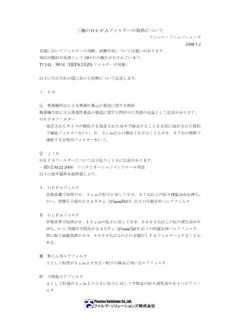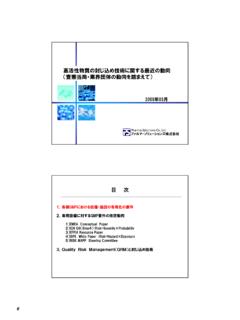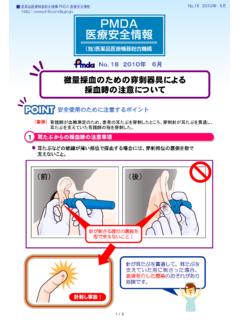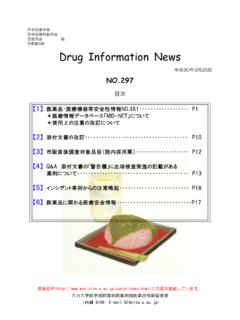Transcription of 対訳資料:PIC/S(EU) GMP Annex 1 Draft
1 EU-GMP Annex -1 1 / 121 2018 3 4 PIC/S(EU) GMP Annex 1 Draft 2017 11 EU(PIC/S) GMP Annex 1 Draft Manufacture of Sterile Medicinal Products PIC/S Draft EC Annex 1 Targeted stakeholders consultation on the revision of Annex 1, on manufacturing of sterile medicinal products, of the Eudralex volume 4 Draft 2018 RO Q&A Work plan for the GMP/GDP Inspectors Working Group for 2018 EMA 2019 1 Annex 1 PIC/S GMP Annex 1 Draft Draft Finalized EU-GMP Annex -1 2 / 121 Document map Section Number General overview 1.
2 Scope Additional areas (other than sterile medicinal products) where the general principles of the Annex can be applied. 2. Principle General principles as applied to the manufacture of medicinal products. 3. Pharmaceutical Quality System (PQS) Highlights the specific requirements of the PQS when applied to sterile medicinal products. PQS 4. Personnel Guidance on the requirements for specific training, knowledge and skills. Also gives guidance to the qualification of personnel. 5. Premises General guidance regarding the specific needs for premises design and also guidance on the qualification of premises including the use of barrier technology.
3 6. Equipment General guidance on the design and operation of equipment. 7. Utilities Guidance with regards to the special requirements of utilities such as water, air and vacuum. 8. Production and specific technologies Discusses the approaches to be taken with regards to aseptic and terminal sterilisation processes. Also discusses different technologies such as lyophilization and Blow Fill Seal (BFS) where specific requirements may be required. Discusses approaches to sterilization of products, equipment and packaging components. Blow Fill Seal (BFS) EU-GMP Annex -1 3 / 121 9 Viable and non-viable environmental and process monitoring This section differs from guidance given in section 5 in that the guidance here applies to ongoing routine monitoring with regards to the setting of alert limits and reviewing trend data.
4 The section also gives guidance on the requirements of Aseptic Process Simulation. Aseptic Process Simulation 10 Quality control (QC) QC Gives guidance on some of the specific Quality Control requirements relating to sterile medicinal products. 11 Glossary EU-GMP Annex -1 4 / 121 1 Scope The manufacture of sterile medicinal products covers a wide range of product types, (sterile active substance through to finished dosage form), batch sizes (single unit to multiple units), processes (from highly automated systems to manual processes), primary packaging materials and technologies ( biotechnology, classical small molecule manufacturing and closed systems).
5 This Annex provides general guidance that should be used for all sterile medicinal products and sterile active substances, via adaption, using the principles of Quality Risk Management (QRM), to ensure that microbial, particulate and pyrogen contamination associated with microbes is prevented in the final product. Quality Risk Management QRM QRM pyrogen bacterial endotoxin RQM PMDA ICH Q9 HP The intent of the Annex is to provide guidance for sterile medicinal products.
6 However some of the principles and guidance, such as contamination control strategy, room qualification, classification, monitoring and gowning, may be used to support the manufacture of other products that are not intended to be sterile (such as certain liquids, creams, ointments and low bioburden biological intermediates) but where the control of microbial, particulate and pyrogen contamination, to reduce it as far as possible, is considered important. EU-GMP Annex -1 5 / 121 2 Principle The manufacture of sterile products is subject to special requirements in order to minimize risks of microbiological, particulate and pyrogen contamination.
7 The following key areas should be considered: a) Facility, equipment and process design must be optimized qualified and validated according to Annex 11 and Annex15 of EU GMP. The use of appropriate current technologies should be implemented to ensure protection and control of the product from potential extraneous sources of particulate and microbial contamination such as personnel, materials and the surrounding environment. a) EU GMP 11 Computerised Systems 15 Qualification and Validation must b) Personnel must have appropriate skills, training and attitudes with a specific focus on the principles involved in the protection of sterile product during the manufacturing, packaging and distribution processes.
8 B) distribution skills training attitudes must c) Processes and monitoring systems for sterile product manufacture must be designed, commissioned, qualified and monitored by personnel with appropriate process, engineering and microbiological knowledge. c) must Processes, equipment, facilities and manufacturing activities should be managed in accordance with QRM principles that provide a proactive means of identifying, scientifically evaluating and controlling potential risks to quality. Risk assessments should be used to justify alternative approaches to those specified in this Annex only if these alternative approaches meet or surpass the intent of this Annex QRM QRM Annex alternative approaches Annex QRM EU-GMP Annex -1 6 / 121 justify Risk Assessment Risk Management RQM principles RQM
9 PMDA ICH Q9 HP Quality Assurance is particularly important, and manufacture of sterile products must strictly follow carefully established and validated methods of manufacture and control. A contamination control strategy should be implemented across the facility in order to assess the effectiveness of all the control and monitoring measures employed. This assessment should lead to corrective and preventative actions being taken as necessary. must The strategy should consider all aspects of contamination control and its life cycle with ongoing and periodic review and update of the strategy as appropriate.
10 Contamination control and steps taken to minimise the risk of contamination from microbial and particulate sources are a series of successively linked events or measures. These are typically assessed, controlled and monitored individually but these many sources should be considered holistically. The development of such strategies requires thorough technical and process knowledge. Potential sources of contamination are attributable to microbiological and cellular debris ( pyrogens/endotoxins) as well as particulate matter (glass and other visible and sub-visible particles).










